Beef Tenderloin on Kamado Joe Reverse Sear
The popularity of outdoor cooking on kamado grills like the Big Green Egg or Kamado Joe has people learning how to reverse sear a steak to cook the perfect steak from the comforts of home.
Today I will teach you the reverse sear method of cooking steaks.
What is the reverse sear method?
Reverse searing is one of the most effective ways to achieve steakhouse quality results at home.
The method is simple. Instead of cooking your steak completely over hot flames or coals, you roast the steak to a specific temperature and then quickly sear it at the very end.
What you're left with is a perfectly cooked steak. Although I prefer to cook a steak over charcoal, this method works just as well using a gas grill.
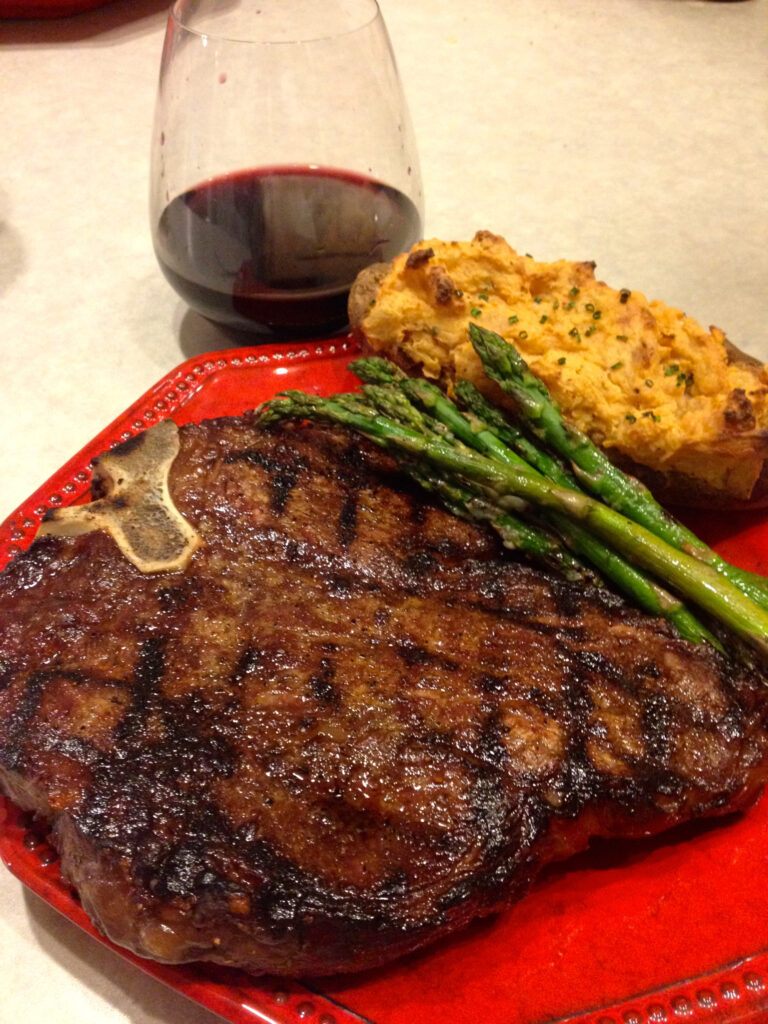
Cook the perfect steak time after time with the reverse-sear method
Why should you reverse sear a steak?
Simply put, the reverse sear is the best way to cook a steak on the Big Green Egg or other charcoal grills.
It allows the steak to have consistent, edge-to-edge doneness with predictable results every time.
I have found that the best way to achieve steak perfection is through the use of a roasting thermometer. It's the key to getting consistent results.
If your steak is too thin to use a roasting thermometer, check out this method of how we like to cook thin steaks on the grill.
How to reverse sear a steak
Reverse searing a steak consists of first roasting the meat to get it close to your desired doneness and then finish the meat by searing.
Be sure to generously season the steak before reverse searing to coax out the maximum amount of flavor.
What is dry brining?
Restaurant chef's often season steak heavily with kosher salt, or dry-brine the steak a few hours before cooking and allow it to rest in the refrigerator on a cookie sheet. The salt causes a chemical reaction and will work magic on the meat making it more delicious.
The dry brine method of salting a few hours before cooking is a restaurant secret and is only now becoming more popular in home cooking.
I suggest putting a dry-brining steak on a wire rack over a rimmed baking sheet, allowing the salt to work its magic inside of the refrigerator. Any juices that may leach from the meat will collect in the pan. Having the steak elevated prevents it from sitting in its own juices which helps promote the Maillard reaction.
Dry brining works equally as well with expensive cuts like filet mignon as it does with flavorful steaks like sirloin.
Does cooking with charcoal add flavor to the steak?
One of the benefits of cooking with charcoal is the delicious flavor it adds to foods.
Some people also prefer to coat the steak with olive oil before reverse searing. This is a matter of preference as it's hard to determine if the olive oil adds any flavor to the meat.
Some people swear by sous vide cooking a steak and then searing it in a cast-iron skillet. This cooking method will make for a very flavorful crust on the meat and is also worth investigating.
For a special treat, consider using the reverse sear method with Wagyu beef like the Wagyu sirloin we use in this recipe. You won't be disappointed!
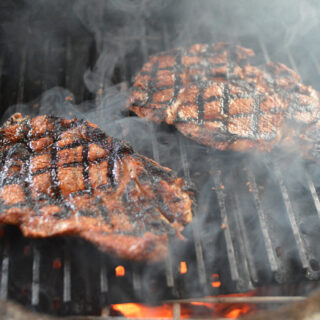
Reverse Seared Steak Recipe
This is a two-step method of cooking steaks.
I must warn you though. Once this technique is mastered, you will be the envy of your friends and skeptical about ever ordering a steak at a restaurant again.
Using a thermometer to make perfectly cooked steaks on the Big Green Egg takes the guesswork out of this dish.
Cooking time does vary some but since we are cooking to temperature, you will still get perfect results every time.
Servings 2 steaks
Calories 651 kcal
- 2 steaks 16 oz each
- 1 tablespoon garlic salt
- 1 tablespoon bbq seasoning
-
Take your steak out of the refrigerator and let it warm up to room temperature for about 45 minutes.
-
Use a sharp knife and trim off any silver skin that is visible. Unless you prefer eating the beef fat, cut off and discard any excess bits of fat as well.
-
Preheat your grill and plan on having it stabilized at about 350F when you begin cooking. Today, I am using the Big Green Egg version of the Kamado style ceramic grills.
-
Season your meat about 10 minutes before you begin cooking. I like to use a combination of a pre-made steak seasoning flavored with garlic powder, salt, and pepper, and a favorite meat rub that has nuances of coriander, cumin, and coffee flavors. Seasoning is simply a matter of preference and at times salt and cracked black pepper simply work best. A word of caution to initially be sparing when using seasonings and rubs with salt added. The salt can often overpower the other flavors.
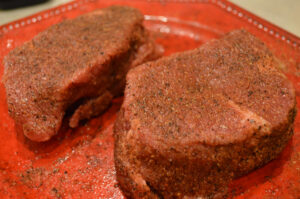
-
Insert a digital meat-roasting thermometer halfway up the thickness of the steak and slide it into the meat as close to the center as possible. Because digital meat roasting thermometer probes are often 4 inches or longer, when inserted in the middle and center of the meat, you get a relatively consistent temperature reading throughout.
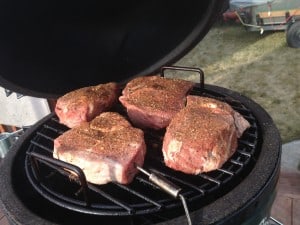
-
The meat will initially be roasted, and then seared before service. Start by roasting the meat indirectly, or not sitting it directly over the flames until your desired temperature is achieved. My grill does not allow me to easily roast the meat near or next to the flame, so I have found that I can achieve the same effect by raising the steak vertically away from the flame. This allows the meat to roast and heat up without being directly charred until I am ready.
-
The Meat Temperature and Doneness Chart has beef steak cooked medium rare at 135F. The meat will continue to cook after it is off of the heat so I like to roast my steak to about 125F and pull the meat off the grill to rest.

-
Remove the meat thermometer and let the meat rest on a plate, covered with foil for a good 10 minutes. This allows the juices to re-distribute.
-
Resist all temptation to cut into the meat and instead go back to your grill and raise the heat by opening the bottom vent and removing the damper top completely.
-
After the meat has rested, the grill should be between 500 and 600F, an ideal temperature for searing.
-
Hot sear the steaks at the higher temperature for about one minute per side.
-
Serve immediately
Be sure to take precautions when searing at a high temperature.
When raising the temperature of your grill for hot and fast searing, be sure to stay nearby and don't walk away.
Closing the lid and opening the damper top and bottom vent will allow the grill to get to searing temperatures quicker. But make sure to not overshoot your searing zone of 500-600F
Long tongs and gloves for hand protection are a good idea.
Searing the meat at a high temperature will give it a beautiful crust, additional grilled flavor, and fabulous grill marks.
Some people prefer to use a cast iron pan for searing or even a cast-iron grilling surface. I've never been a fan of cast iron and find it to be overrated for a variety of reasons.
Instead, I use GrillGrates.
GrillGrates are a hard-anodized aluminum cooking surface that both amplifies the heat of the grill and also smooth out any hot spots that can occur when using hardwood lump charcoal.
Quickly searing the steaks close to the coals after roasting gives the steaks nice char and extra flavor.
Serving: 1 g Calories: 651 kcal Carbohydrates: 3 g Protein: 61 g Fat: 42 g Saturated Fat: 17 g Polyunsaturated Fat: 19 g Cholesterol: 223 mg Sodium: 2737 mg Sugar: 1 g
Let us know how it was!
-
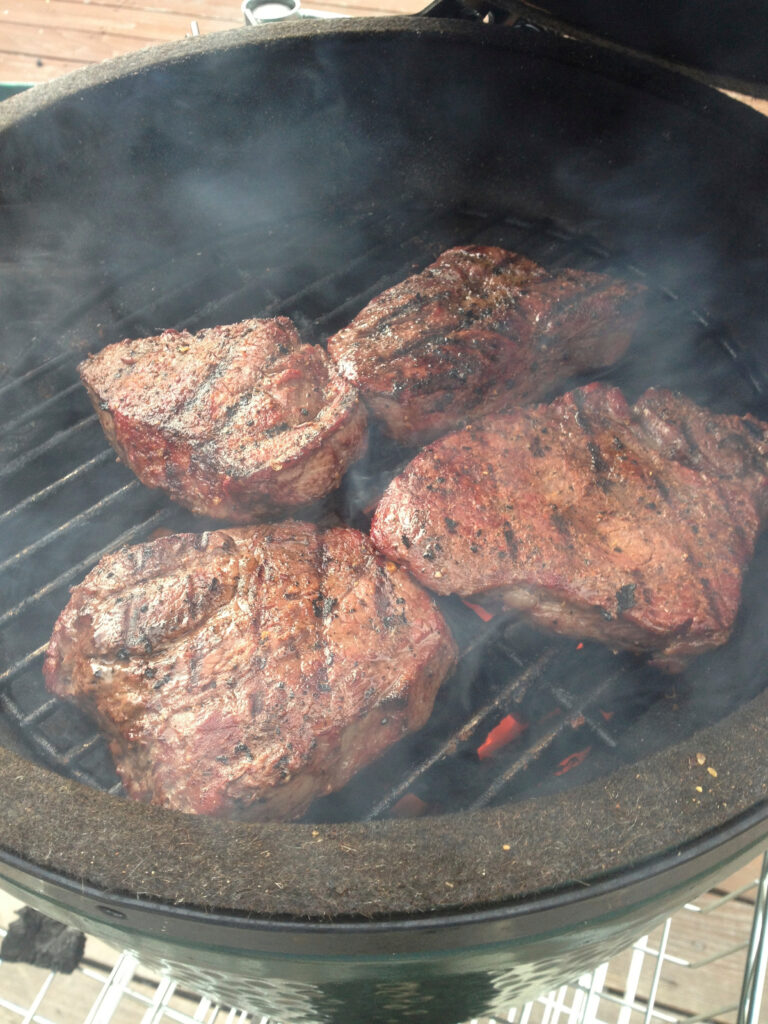
Quickly searing the steaks close to the coals after roasting for a nice char and extra flavor
By monitoring the internal temperature of the meat you know that it will be cooked to your desired doneness.
Allowing the meat to roast slowly enhances the flavor of the meat while keeping it juicy.
The reverse sear method takes the guesswork out of grilling the perfect steak.
Now if I can just figure out how to pick the perfect glass of wine to go with it.
Reader Interactions
Source: https://grillingmontana.com/how-to-grill-the-perfect-steak-reverse-sear-method-grilling-montana/
0 Response to "Beef Tenderloin on Kamado Joe Reverse Sear"
Post a Comment